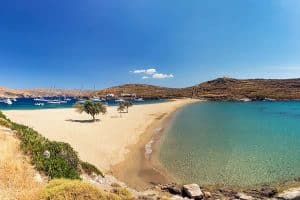From Santorini’s breath-taking sunsets to Crete’s beautiful beaches, the Greek islands have long drawn tourists from across the world.

With spectacular scenery, gorgeous weather and fascinating history, the allure of these islands isn’t exactly a secret – and around 30 million visitors flock to Greece each year. But what if you’re looking to escape the crowds and discover a hidden gem? The good news is that Greece has hundreds of gorgeous islands you might not have heard of – so if you want to beat the crowds and find some peace, here are 10 islands you might want to visit.
Ikaria (also known as Icaria)
If you’re interested in Greek mythology, you might want to visit Ikaria; named after Icarus, who supposedly crashed here after his wax wings melted when he flew too close to the sun. This island is also said to be the birthplace of Dionysus, the god of wine. Ikaria is a Greek island like no other, and it’s celebrated for its independent, quirky spirit, as well as its wild and diverse terrain.
Here you can walk through forested gorges, explore alien-like rock formations, swim in beaches with sparkling cobalt waters, and even bathe in radioactive hot springs – the latter of which is said to be a reason why the locals here live so long. You might also want to try some of the special herbs and teas the locals swear by while you’re here, too! Though Ikaria isn’t a busy or crowded island, it’s known for its high-spirited village festivals. So if you’re looking for a more obscure destination that’s still fun and lively, this might be the island for you!
Halki
Just a quick ferry ride from Rhodes, Halki couldn’t be more different than its big, bustling neighbour – and with no cars or motorbikes allowed, this sleepy island is a true oasis of calm. UNESCO refers to Halki as “the island of peace and friendship”, and as you arrive in the elegant 19th-century port town of Emborio, with its grand mansions and shady courtyards, it’s a safe bet that you’ll fall in love with Halki at first sight. Head to the interior of the island to climb up to the fascinating ruins of Horio, the former capital, and admire the medieval castle, the Knights of St. John, where you can enjoy stunning views across the island.
The beaches around Emborio are all pretty decent, but head to the North Coast if you want to kick back on more secret, spectacular beaches – or take a boat out to the uninhabited island Alimnia, where you can really get away from it all.
Kythnos (pictured)
Due to its close proximity to Athens, the island of Kythnos is often filled with Greek tourists in August. But throughout the rest of the year, it’s a quiet and low-key destination that remains pretty undiscovered. With only one bank on the island and two ATMs, this is a place where you can get a sense of how Greece used to be back in the day – and if you’re looking to enjoy some rest and relaxation away from the crowds, you’ll certainly find that here.
There are several wonderful beaches on the island, and there’s also a truly stunning sandbar that joins Kythnos to the islet of Agios Loukas. There are Venetian castle ruins to admire in Kastro Tis Grias, as well as hot springs you can soak in at Loutra: a lovely fishing harbour that makes a great base. Villages like Hora and Dryopida are also pretty and laidback bases. If you’re looking to explore the great outdoors, be sure to visit the enormous caves here; the entire island used to hide in here from raiders!
Chios
If you think Greek villages all look a bit samey with whitewashed, sugar-cube houses and bright blue church domes – then head to the island of Chios which is sure to change your mind! This is a Greek island that’s one of a kind, and the distinctive, fortress-like architecture of its villages, as well as their bright painted geomatics and colourful motifs, will give you an architectural experience that’s truly unique. To the North of Chios are dramatic, lonely mountains you can ramble over, and in the South of the island, the famous painted villages beckon. In the centre, the buzzing port capital provides plenty to see and do.
There are also sea caves to swim in, oak and pine-lined canyons to explore, and lots of lovely beaches – be sure to visit pretty Vrontados, where you can sit upon Homer’s Seat – which is said to be where the famous poet (a Chios local!) wrote his poems.
Astypalea
Beautiful, butterfly-shaped Astypalea is quite simply a haven of peace, and this little-known island makes the perfect out-of-the-way retreat. Though it’s the westernmost island of the Dodecanese islands, Astypalea has typically Cycladic architecture – and the small and unspoilt hillside capital of Chora is packed with white cubic houses, gently spinning windmills and grand Venetian castles. Astypalea’s beaches are beautiful and diverse, ranging from the lively Livadia, with its beachside tavernas, to the wilder, more isolated coves of Vatses and Kaminakia.
The island has an interesting history, and its rocky Vathy peninsula is known to be the home of the world’s oldest homoerotic graffiti! There’s also a 2,750-year-old infant cemetery at Kylindra, and ancient mosaics of zodiac symbols in the baths of Talara. So if you’re fascinated by Greek history, there’s lots to see and do here.
Kythira
Known as the legendary birthplace of Aphrodite, the Greek goddess of love, Kythira is a magical destination that can make you feel as though you’ve fallen into a dream. With wild and overgrown gorges, flower-adorned cliffs, and shimmering, fjord-like inlets, Kythira is technically an Ioanian island. Though its Cycladic architecture and geographical position – sandwiched between the Aegean and Ionian Seas, just a few miles from the Peloponnese Peninsula – make this island truly unique. As you walk through Kythira’s wooded ravines, you’ll be surrounded by the overwhelming scent of wild oregano, which is one of the island’s main exports – and makes a great souvenir to take home, too.
There are also sea caves to explore, spectacular frescoed churches to admire, and plenty of vineyards where you can sample local wines and learn about the island’s wine-producing history. The neighbouring island of Elafonisos, which is just a short water taxi ride away, also has some of the best beaches in the Med.
Patmos
Patmos is another Aegean island with an otherworldly feel about it, and its history is certainly spiritual. Legend says that Patmos was once a secret underwater island until Selene, the Greek goddess of the moon, lifted it above the surface and illuminated it – and if you know your Bible, you might also know that St John wrote the Book of Revelation on Patmos.
While some tourists visit Patmos for religious reasons, few stay more than a day, and even fewer visit more than the island’s main monasteries before leaving. But Patmos has so much more to offer… This seahorse-shaped island is lined with beaches and hidden coves, but its interior is equally beautiful, and the dramatic volcanic landscape boasts mysterious caves, dramatic peaks and lush green valleys that are perfect for exploring by foot.
The fortress Monastery of St. John the Theologian in the capital of Chora is a must-visit, and the old town is home to many excellent tavernas and bars where you can soak up the authentic atmosphere.
Milos
If you’re looking to visit an island that’s breathtakingly beautiful, Santorini might be the island that first comes to mind. But if you’re looking for peace and quiet, and space away from the crowds, you won’t find that there. Instead, why not head to another nearby Cyclades island, and visit Milos instead?
Famous for being the home of the Venus de Milo, this volcanic horseshoe-shaped island boasts truly awe-inspiring landscapes – from multicoloured rock formations to dazzlingly blue crystalline waters.
This is an island of beaches, and whether you prefer bare, wild beaches or those lined with plenty of bars and tavernas, you’ll be spoilt for choice. The fishing harbours are a joy to explore, particularly Klíma and Mandrákia, with their photogenic, bright coloured boathouses.
There’s also a network of Paleo-Christian catacombs carved into the vertical rock, as well as the remains of a Roman theatre, so if you’re all beached out, there’s plenty of history and culture to keep you busy here, too.
Lefkada
Tucked between the Greek mainland and the popular island of Kefalonia, the little-known island of Lefkada boasts some of the most breath-taking natural landscapes in the Ionian region – including many of the best beaches. Though it’s connected to
the mainland by a bridge, Lefkada remains a discreet island, and its shockingly blue waters are far quieter than those of its neighbouring islands. Though it’s only 35km long and 15km wide, it never feels crowded, even in summer.
Lefkada is the windsurfing capital of Europe, so if you’re looking to try your hand at water-sports during your break, this is the place to come – though the island’s sandy beaches are perfect for relaxing on too. The most beautiful beaches, like Porto Katsiki, Egremni, Gialos and Kathisma, are all located on the West Coast.
The main resort town of Nydri has a lively marina and plenty of busy bars and restaurants, though Vassiliki is another popular
town. Or, for an adventure you won’t forget, hike to the Dimosari ravine – and then cool off by diving under the waterfall into the
refreshing pool!
Sifnos
Another island that’s popular with Greeks yet pretty unknown to Brits is Sifnos. Though it can get a bit crowded during the summer months, this is an island that’s as authentic as it is cool, attracting foodies, history buffs and trendy Athenians alike. Most visitors flock to the Southern half of the island, but the best beaches – especially if you want to enjoy a sense of tranquillity – are in the North. Once a hub for gold and silver mining, these days Sifnos is known for fine food, pottery, and basket weaving.
The capital town Apollonia is hip and happening, and on the main street (the Steno) there are plenty of top-quality tavernas that’ll help you understand why Sifnos has such a reputation as a culinary hotspot. If you eat too much during your holiday, there’ll be plenty of chances to walk it off, as the island is known for its excellent hiking trails – and the olive groves in the central mountains are perfect for exploring on foot.
Final thoughts…
Greece is one of the most diverse holiday destinations in the world, and if you think you’ve already explored all of the Greek islands, we hope this article has inspired you!
As the home of western civilisation, Greece is packed with history and culture, and its islands are home to fascinating ruins and enthralling myths and legends. But if you’re just in the mood for sun, sea and sand, the turquoise blue waters and pristine beaches of the Mediterranean are all around you.
Whether you want to hike and swim on your break, visit museums or archaeological sites, or just relax in a laidback taverna enjoying fresh food and listening to local music, these Greek islands have it all. Just with fewer crowds, and more peace.
(Article source: Rest Less)

